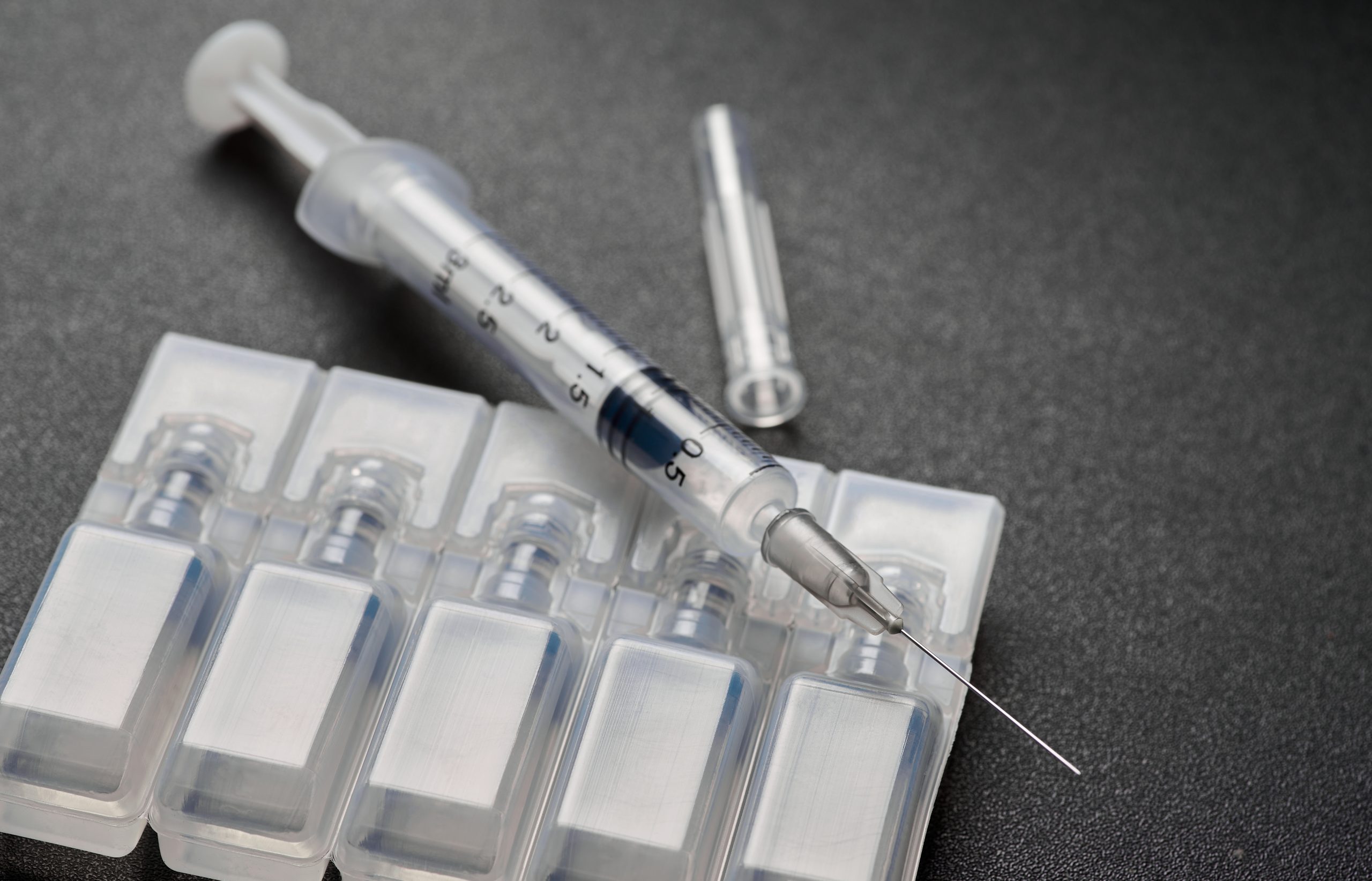According to Chavda et al. (2022), intra-articular hyaluronic acid (HA) injections offer limited, temporary relief for mild to moderate knee osteoarthritis when other treatments fail. This study underscores the therapy’s safety and lasting symptomatic relief for six months.
Intra-articular hyaluronic acid injections have been recognized for their effectiveness in improving joint function and mobility of knee osteoarthritis (OA) patients. For individuals searching for non-surgical solutions, intra-articular HA therapies offer significant improvements. Brands like Orthovisc and Durolane offer targeted approaches to managing knee OA and improving patients’ quality of life.
This article will discuss osteoarthritis and intra-articular HA treatments and compare Orthovisc vs Durolane based on their formulations, mechanism of action, safety, and efficacy.
Key Takeaways
- Intra-articular hyaluronic acid injections require direct administration into the affected knee joint and aim to restore the synovial fluid’s viscoelasticity.
- Both offer lubrication and cushioning for the joints; however, Orthovisc derived HA from rooster combs, and Durolane uses its patented NASHA technology.
- Orthovisc and Durolane have shown clinical efficacy in treating knee OA symptoms.
- Orthovisc requires 2 mL per shot for three to four injections, while Durolane is a single-injection therapy with 3 mL per shot.
- While most individuals can receive these injections, individual treatment responses may vary, and each patient needs the guidance of medical professionals to achieve safe and effective treatment.
About: Medica Depot is your trusted all-in-one supplier, offering a range of high-quality medical injectables and supplies. If you’re looking to buy Orthovisc, you can do so on Medica Depot quickly and easily. We offer a worry-free experience in searching for the best and most popular products on the market. Whether for health professionals, plastic surgeons, dermatologists, licensed estheticians, or other specialists, we can offer genuine, brand-name products you may need. With Medica Depot, we prioritize serving you better to improve the patient’s quality of life.
Introduction to Orthovisc and Durolane
Osteoarthritis (OA) is a degenerative joint disease, often characterized by chronic pain, swelling, and stiffness. OA typically occurs when joint tissues break down over time, affecting joints such as the hands, spine, hips, or knees.
Intra-articular treatments can address knee OA concerns, specifically hyaluronic acid (HA) injections. These injections require direct administration into the affected knee joint and aim to restore the viscoelasticity of the joint’s synovial fluid. HA injections like Orthovisc and Durolane provide pain reduction and improved functional mobility.
Comparing Orthovisc and Durolane is crucial for medical professionals to determine the most suitable HA injection treatment for each patient. They may also compare other solutions like Orthovisc vs Supartz, but providers can align the therapy to the patient’s needs, goals, response, OA condition, and overall health.
Formulations and Mechanisms of Action

Orthovisc and Durolane capitalize on hyaluronic acid’s potency in treating knee osteoarthritis (OA) patients. Hyaluronic acid (HA) is a natural substance found in the body, primarily in the joints, that allows pain-free movement and improved function.
These intra-articular HA injections have similar mechanisms of action when injected into the affected joints. They restore the physiological viscoelasticity in the synovial fluid. Orthovisc and Durolane work as lubricants and shock absorbers, reducing pain and enhancing joint mobility.
Orthovisc’s formulation has a high molecular weight of hyaluronic acid derived from rooster combs. It involves a 30 mg or 2 mL viscoelastic gel. Meanwhile, Durolane has 3 mL in its formulation, utilizing the non-animal stabilized hyaluronic acid (NASHA) technology.
While they have similar mechanisms of action, Orthovisc and Durolane differ in their HA source and formulation. Both offer lubrication and cushioning for the joints; however, Orthovisc derived HA from rooster combs, and Durolane uses its patented NASHA technology.
Orthovisc and Durolane’s Clinical Efficacy

Neustadt et al. (2005) conducted a randomized controlled trial with 372 participants to demonstrate Orthovisc’s efficacy. The research confirmed that Orthovisc’s high-molecular-weight injection is a safe and effective treatment for knee osteoarthritis (OA). 76% of the patients reported significant enhancement in pain scores, and improvement exceeded 20%.
Meanwhile, Leighton et al. (2018) created a clinical evidence review regarding Durolane NASHA technology’s efficacy in treating knee OA. The study underscores that the single-injection therapy demonstrated sustained and effective knee OA symptomatic relief with a low rate of adverse events. Durolane’s NASHA technology can be beneficial for the management of knee OA.
Both Orthovisc and Durolane have shown clinical efficacy in treating knee OA symptoms. They can efficiently provide symptomatic relief, enabling patients to return to active lifestyles.
Dosing Regimens

This factor refers to administering specific amounts of medication at required intervals. Following the dosing regimens of Orthovisc and Durolane can help healthcare providers maximize the therapeutic benefits of these injections while minimizing their potential risks and adverse events.
- Recommended Orthovisc Dosing Regimen: The typical Orthovisc dosage administration is 2 mL per affected knee joint. It requires direct administration of the intra-articular injection into the knee joint once a week, for three to four shots for a complete cycle.
- Recommended Durolane Dosing Regimen: Compared to Orthovisc, Durolane only requires a single injection for an entire treatment. The recommended Durolane dosage is 3 mL. The intermediate joints may need 1 to 2 mL, while smaller joints require 1 mL.
These injections require direct administration of the affected knee joint using an aseptic technique. However, Orthovisc and Durolane differ in the number of injections and solution dosage. Orthovisc requires 2 mL per shot for three to four injections, while Durolane is a single-injection therapy with 3 mL per shot.
Safety Profiles
Products’ safety profiles inform medical professionals and patients about treatments’ potential side effects and risks. This information is crucial for understanding the safety and tolerability of Orthovisc and Durolane injections.
Patients can expect to encounter common side effects after Orthovisc knee injections treatment. While the therapy is generally well-tolerated, it may still cause temporary side effects and are usually harmless. However, if these persist, immediately contact your trusted doctor.
- Pain
- Swelling
- Heat
- Rash
- Itching
- Bruising
- Redness
Moreover, its contraindications can help medical professionals assess which patients are best candidates for Orthovisc knee injections.
- Do not administer to patients with known hypersensitivity to hyaluronate preparations.
- Do not administer to patients with known allergies to avian or avian-derived products.
- Do not inject Orthovisc into patients with infections or skin diseases in the area of the injection site or joint.
On the other hand, Durolane-treated patients may suffer from several temporary side effects after treatment. These may subside over time once the body adapts to the medicine. However, promptly ask for medical attention if the symptoms last over a week.
- Mild to Moderate Pain
- Mild to Moderate Swelling
- Mild to Moderate Stiffness
Durolane shared a few conditions that should avoid receiving the injection. By any chance that patients have or experience these symptoms, medical professionals must not continue with their Durolane knee injections.
- Do not use Durolane for patients with infections or skin disease at the injection site.
- Do not use Durolane for patients with hypersensitivity or allergy to hyaluronate preparations.
It’s also worth noting that Orthovisc and Durolane have not been tested in pregnant, lactating, or child-bearing women or children. While most individuals can receive these injections, individual treatment responses may vary, and each patient needs the guidance of medical professionals to achieve safe and effective treatment.
Conclusion
Orthovisc and Durolane are effective intra-articular treatments for knee osteoarthritis (OA). These hyaluronic acid-based injections act as lubricants and shock absorbers in the joint, reducing pain and enhancing mobility. Their mechanisms of action provide symptomatic relief and enable patients to maintain an active lifestyle, but differ with their hyaluronic acid formulations.
Orthovisc typically requires multiple injections over several weeks, while Durolane is a single-injection treatment. Nonetheless, both demonstrated clinical efficacy and safety in treating osteoarthritis symptoms. The medical professional’s choice between Orthovisc and Durolane should be based on individual patient needs, responses, goals, and health.
FAQs
1. What are Orthovisc and Durolane, and how do they treat knee osteoarthritis (OA)?
Orthovisc and Durolane are hyaluronic acid (HA) injections used to treat knee osteoarthritis (OA). They are administered directly into the affected knee joint to restore the viscoelasticity of the joint’s synovial fluid, reducing pain and improving functional mobility.
2. How are Orthovisc and Durolane different from each other in terms of their formulation and mechanism of action?
Orthovisc and Durolane have similar mechanisms of action as they both aim to restore the physiological viscoelasticity in the synovial fluid. However, they differ in their HA source and formulation. Orthovisc is derived from rooster combs, while Durolane uses its patented non-animal stabilized hyaluronic acid (NASHA) technology.
3. What is the recommended dosing regimen for Orthovisc and Durolane?
Orthovisc requires 2 mL per shot for three to four injections, while Durolane is a single-injection therapy with 3 mL. The recommended Orthovisc injection frequency is once a week, for three to four shots, for a complete cycle. On the other hand, Durolane only requires a single injection for an entire treatment.
References
- Chavda, S., Rabbani, S. A., & Wadhwa, T. (2022). Role and Effectiveness of Intra-articular Injection of Hyaluronic Acid in the Treatment of Knee Osteoarthritis: A Systematic Review. Cureus, 14(4), e24503. https://doi.org/10.7759/cureus.24503
- DUROLANE. (n.d.). Bioventus OA Knee Pain Relief. https://durolane.com/en/durolane/faq/









